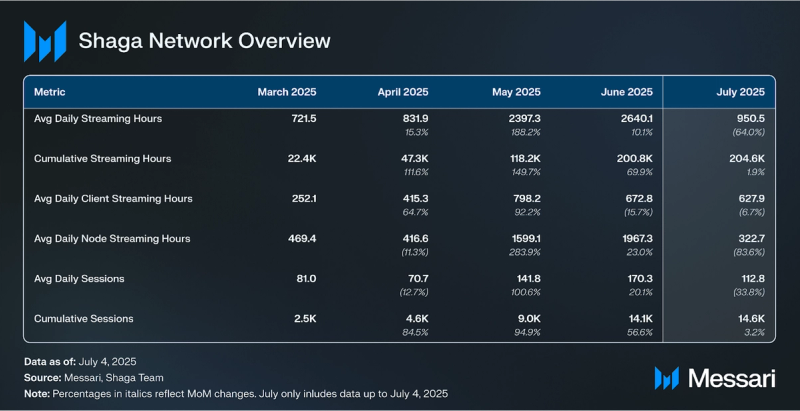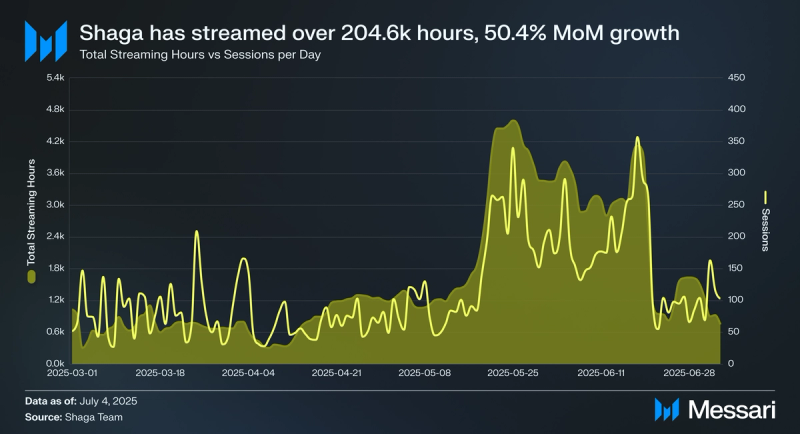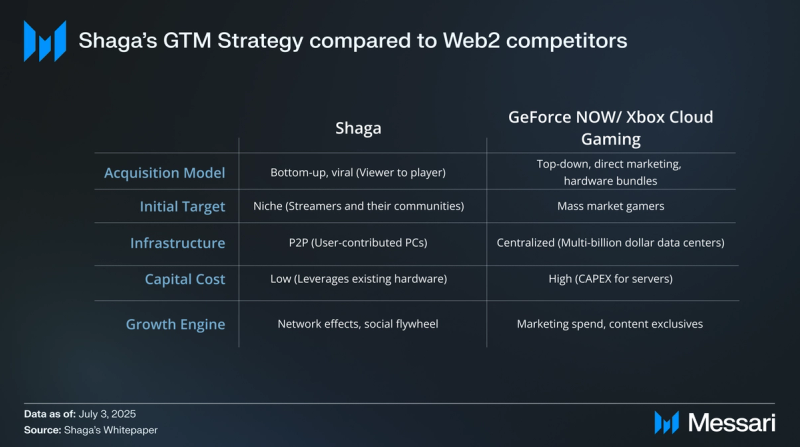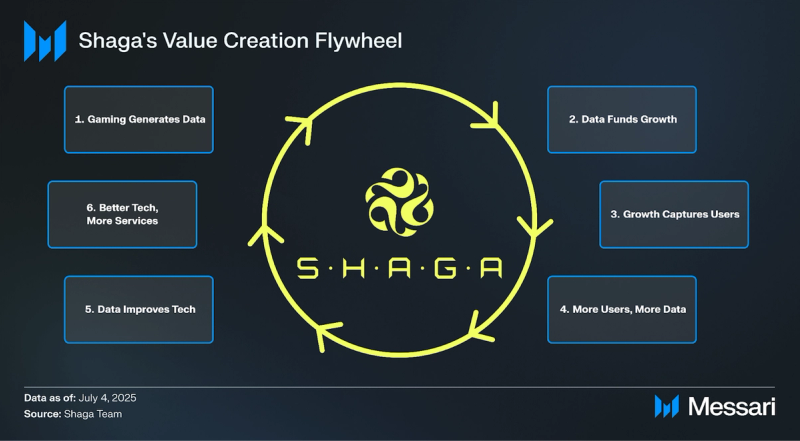and the distribution of digital products.
DM Television
Shaga: The First Fully-Integrated Consumer Compute Network
- Shaga is a DePIN cloud gaming platform that transforms idle high-end gaming PCs into a decentralized, low-latency streaming network. The project aims to offer a scalable and cost-effective alternative to centralized streaming services.
- The project's go-to-market strategy centers on streamers, who act as the initial node operators and attract users through a "viewer-to-player" feature that allows audiences to join games instantly.
- Shaga's long-term vision extends beyond gaming and into a distribution platform that challenges Steam, underpinned by physics-based tokenomics and proprietary innovations like Neural Game Codecs.
- Since launching invite-only testing, the platform has gained 404,200 connected wallets, 767 active nodes, 3,051 active clients, and over 204,000 streaming hours.
Shaga is a decentralized physical infrastructure (DePIN) network built on Solana that turns idle gaming PCs into a distributed cloud gaming platform from users providing their compute. The project's thesis begins with a significant market inefficiency: an estimated 59.5 million high-specification gaming PCs, representing billions of unutilized GPU-hours daily, sit dormant for up to 80% of the day. Shaga aims to capture this wasted resource by enabling PC owners to monetize their hardware by streaming games to users who lack the resources, allowing them to play on weaker gaming devices, thereby solving the high costs and scalability issues that have plagued centralized cloud gaming services. Shaga is led by industry experts Guido Pardini (CEO), Daeshawn Ballard (COO), and Aaron Sternberg (CRO).
The platform is designed as a vertically integrated solution, combining compute, storage, and bandwidth from a single peer's machine to deliver a low-latency experience. Shaga argues this architecture is fundamentally superior to using fragmented DePIN solutions, where routing between different networks for storage, compute, and streaming would introduce unplayable levels of lag.
According to project data, Shaga's initial invite-only phase has attracted a waitlist of over 688,000 users and delivered 204,000 streaming hours, suggesting significant early demand for its community-owned gaming infrastructure. Shaga has raised $5 million and is backed by Anatoly Yakovenko (Founder of Solana), Stephen Akridge (Cofounder of Solana), Amir Haleem (Founder of Helium), Yuan Gao (Founder of Gradient), and others.
The Problem: An Inefficient MarketThe modern gaming landscape is defined by a paradox of wasted resources and unmet demand. Shaga identifies the supply-side inefficiency as 59.5 million cloud-capable gaming PCs, defined as systems with at least an RTX 3060 GPU and 32GB of RAM, that sit idle for most of the day. This represents a vast, distributed reservoir of high-performance compute, collectively valued in the hundreds of billions of dollars, that generates no value while inactive.
Simultaneously, the market exhibits critical failures and bottlenecks that prevent this latent supply from meeting existing demand:
- Centralized Cloud Gaming is Flawed: Incumbent services like NVIDIA's GeForce NOW face enormous capital and operational expenditures from building and maintaining data centers, costs that are passed on to consumers. Others, like Google's Stadia, have failed entirely, unable to create a profitable model. These services are often limited in performance, capping resolutions or frame rates to manage load.
- Massive Unmet Demand: Market research indicates that over 505 million people worldwide will be interested in cloud gaming by 2030. This demand is driven by players who want access to AAA titles without investing in expensive, rapidly depreciating hardware.
- Exploitative Distribution Models: Game publishers, the creators of the content, are forced to forfeit as much as 30% of their revenue to centralized distribution platforms like Steam. This "platform tax" stifles innovation and inflates consumer prices.
- Fragmented Compute Markets: While the AI industry is starved for GPU resources, it cannot effectively tap into the consumer market's idle hardware due to logistical challenges, privacy concerns, and a lack of appropriate infrastructure to aggregate and manage these distributed resources.

Shaga’s core thesis is that the solution to these problems lies at the edge when dealing with the gaming PCs. The project posits that a standard high-end gaming PC is the perfect, pre-packaged unit for a cloud gaming network. Unlike generalized DePIN approaches, which would require stitching together services from different networks. For instance, fetching game files from a storage network like Filecoin, sending them to a compute network like Render, and then routing the video through a streaming network like Livepeer, Shaga leverages the all-in-one nature of a gaming PC. Each machine already contains the necessary components in one physical location: a powerful GPU, a multi-core CPU, fast RAM, high-speed NVMe storage, and a high-bandwidth internet connection.
This model is critical for solving the primary challenge of cloud gaming, latency. By keeping all operations on a single machine, Shaga avoids the compounding network hops between disparate services. It estimates those hops could add 120-370ms of lag, rendering any fast-paced game unplayable. Instead, the user connects directly to a single peer, creating the shortest possible path for data transmission.
To support its long-term vision, Shaga has designed its node software with a modular architecture. The node consists of distinct components, including a Game Stream Module, a Files Sync Module, and an AI Inference Module. This design allows Shaga to seamlessly introduce new functionalities, such as file distribution or AI workloads, in the future. The network can evolve its capabilities without requiring a fundamental re-architecture, enabling a phased rollout that begins with gaming and expands from there.
Current Traction Since Launch
Since launching invite-only in March 2025, Shaga has reached 204,600 total streaming hours. This was a 70% MoM growth from May to June (July data only includes to July 4). In June, the average daily streaming hours were 2,640.1, a 10.1% MoM increase. 75% of hours came from nodes, and 25% of streaming hours came from clients. Also, in June, the average daily sessions were 170.1, a 20.1% MoM increase, resulting in 14,600 cumulative sessions since launch.
 Technical Innovation: Building a Defensible Moat
Technical Innovation: Building a Defensible MoatTo deliver an experience that feels indistinguishable from video gaming on local hardware, Shaga is developing proprietary technologies designed to overcome cloud gaming's physical limitations. The network's vertically integrated design makes these innovations possible, and they form a key part of the competitive moat it aims to create.
Neural Game Codecs (NGC) and the Neural CDNA traditional video codec compresses and decompresses a video stream, a process that inherently adds latency. Shaga’s proposed solution is a revolutionary paradigm shift that moves beyond simple compression to what it terms "causal reconstruction." This technology, the Neural Game Codec (NGC), functions as a Neural Content Delivery Network (nCDN). Instead of just sending pixels (what you see), SHAGA sends causality (why you see it), it's like shipping a recipe and a few key ingredients instead of the fully cooked meal.
The NGC is an AI-driven codec trained specifically on individual game data. The technical breakthrough lies in two areas:
Causal Redundancy and a Delta Correction Mechanism. The AI is fed the player's real-time controller inputs, not just the previous frames, allowing it to predict what the player is trying to do. The system reconstructs the predicted frames locally on the user's device, and only the unpredictable, hard-to-model elements (like sudden explosions or user interface pop-ups) are sent as tiny "delta corrections" to ensure the picture is perfect.
The result is a leap in efficiency. This method is projected to reduce bandwidth requirements by 75%, from a standard 6 Mbps stream to just 1.5 Mbps. This means a single node with a 100 Mbps connection could potentially serve 200 concurrent streams instead of just 16, dramatically increasing network capacity and profitability.
This creates a powerful cycle: the more people use the network, the more data is generated to train and improve the NGCs. Shaga uses its own distributed compute to constantly train on its own data, meaning every gaming session makes the entire network smarter and more efficient. This approach allows for the rapid creation of hyper-optimized, game-specific codecs, creating a permanent and compounding technological moat that centralized services cannot replicate because they do not control the edge compute. While still in the research phase, Shaga believes this technology could ultimately reduce streaming latency to as low as 3-7ms.
This technological advance has profound business implications, positioning Shaga to obsolete traditional CDNs. For context, a service like Twitch burns an estimated $4 - $6 million per year on bandwidth costs to deliver video streams to its audience. With Shaga's NGC technology, the top 10 most-streamed games, which consume the vast majority of bandwidth, can be transformed from massive cost centers into profit centers. The efficiency is so great that streamers could broadcast high-quality game streams from a mobile data connection, requiring as little as 0.5 Mbps instead of the current 6+ Mbps standard.
Control BifurcationIn a typical multiplayer cloud gaming session, a player's inputs (like a mouse click or keypress) travel from the player to the streaming node, which then relays them to the game's central server. Shaga identified this relay as an unnecessary source of latency. Its Control Bifurcation solution (still in development) will intelligently split the data paths. Player inputs are sent directly to the game's multiplayer server, while the video stream continues to flow from the peer-to-peer node. By cutting out the middleman for game inputs, this system is projected to reduce multiplayer lag by 15-45ms, a significant and often game-changing margin in a competitive environment.
Go-to-Market: Strategy and Value CreationShaga’s path to market is built on a self-reinforcing flywheel that combines a targeted user acquisition strategy with a unique data arbitrage opportunity, creating a sustainable growth engine.
A Streamer-Centric StrategyOne of the most significant hurdles for any two-sided marketplace is the "cold start" problem of attracting an initial critical mass of both supply and demand. Shaga addresses this with a highly targeted go-to-market strategy centered on video game streamers that are viewed not just as users but as foundational business partners who can kickstart the entire network.
This strategy is effective for several reasons:
- They Are Natural Infrastructure Owners: Top streamers already own the high-end PCs (e.g., with RTX 4080/4090 GPUs) required to be effective nodes.
- They Are Business Operators: Streamers are constantly seeking new ways to engage their audience and monetize their brand. Shaga offers them a direct way to earn revenue from their hardware's idle time.
- They Solve the Licensing Dilemma: Game licensing is a complex legal hurdle for cloud gaming. However, streamers often operate with commercial licenses for the games they broadcast, neatly sidestepping this issue for Shaga's initial growth phase. While a broader "Bring Your Own License" (BYOL) solution is being developed for the gamer. Gamers would be able to log into their Steam account and then play the game anywhere, on any device.
The lynchpin of this strategy is the viewer-to-player viral loop. Shaga's platform includes a feature that allows streamers to place a "Join Game" button directly on their stream. With a single click, a viewer can instantly play the game, with the session hosted on the streamer's own PC. This transforms passive viewing into active participation, creating highly engaging content that attracts more viewers. Some of these viewers may then be inspired to become players themselves or even set up their own nodes, creating a self-perpetuating cycle of organic growth.
 The Veo3 Data Crisis and Arbitrage Opportunity
The Veo3 Data Crisis and Arbitrage OpportunityThis initial user activity plugs directly into a massive, unaddressed market opportunity created by advances in AI. While technologies like Google's Veo3 have made video generation significantly cheaper, they require immense amounts of data to function. For interactive content like gaming, the necessary data, synchronized game frames, plus controller input pairs, does not exist at scale. Google's exit from the market with Stadia left them with no way to collect this crucial data.
This is where Shaga’s strategic advantage emerges. Every gaming session on the Shaga network generates the exact data needed to train interactive AI models. Based on market comparables, this data is incredibly valuable, estimated to be worth between $5 and $60 per hour. This creates a unique arbitrage opportunity: Shaga can sell the gaming data generated on its network to fund user subsidies, making the platform free or nearly free for players. This provides a stark competitive advantage against incumbents like GeForce NOW, which charges users around $20 per month.
The Three-Way Value Creation Flywheel
These components, the go-to-market strategy and the data arbitrage, combine to create an unstoppable, three-way value creation flywheel. The cycle functions as follows:
- Gaming Generates Data: The streamer-centric strategy kickstarts gaming sessions, which produce valuable, synchronized frame and input data pairs.
- Data Funds Growth: The sale of this data funds user subsidies, making Shaga's service highly affordable or free.
- Growth Captures Users: The subsidized pricing model attracts users away from more expensive, centralized competitors.
- More Users, More Data: A larger user base generates even more data, which both increases revenue and deepens the network's data moat.
- Data Improves Technology: The data is also fed back into Shaga's own network to train better Neural Game Codecs, continuously reducing operational costs and improving stream quality.
- Better Tech, More Services: Improved codecs increase network efficiency, enabling new services like the Neural CDN and further solidifying Shaga's market position.
Shaga's ambition is not only to build a cloud gaming service but also to execute a long-term strategy in which each phase builds the foundation for the next, culminating in a disruption of the entire game distribution market.
- Phase 1 - Streamer's Tool (Current): The initial focus is on the "play with your favorite streamer" mechanic. This phase is designed to prove the technology, build a core community, and aggregate a critical mass of nodes by providing a clear, immediate value proposition to streamers.
- Phase 2 - Cloud Gaming Platform (Years 1-2): With a network of nodes in place, Shaga will expand into a general cloud gaming service, akin to a "Netflix for games." The project targets an industry-average Average Revenue Per User (ARPU) of $17.50 per month, with a proposed 75/25 revenue split favoring the node operators to ensure a healthy supply side.
- Phase 3 - Decentralized Steam (Years 3-5): Once at scale, Shaga will activate the file synchronization module on its nodes, transforming the network into a peer-to-peer game distribution platform. By offering publishers a 95% revenue share (compared to the 70% they receive from Steam), Shaga aims to present an irresistible economic proposition to game developers, thereby lowering game prices for consumers and creating a more equitable market.
- Phase 4 - World Cognition Market (Long-Term): In its final phase, Shaga envisions the network evolving beyond gaming. The vast distributed compute grid, combined with the valuable datasets generated from training the Neural Game Codecs, would position Shaga as a major player in generative AI and other intensive computing markets.
Underpinning this multi-stage plan is a tokenomic model designed for long-term sustainability, which the project calls "Physics-Based Tokenomics." The core idea is to tie token emissions directly to verifiable, real-world work, specifically the consumption of electricity. This reframes token emissions not as a cost, but as a direct infrastructure investment. Every token emitted represents real electricity performing real work, creating a transparent and defensible value creation model.
The emission formula is defined as:
Token Emission = (Power Consumed × Electricity Rate) × Emission knob.
This model has several key implications:
- Verifiable Work: It is difficult to fake the result of electricity consumption, which grounds the network's reward system in tangible work and prevents inflationary abuse.
- Economic Alignment: Emissions are only generated when the network is performing useful tasks (rendering games, training AI models), ensuring that the tokens emitted are directly linked to demand being served.
- Natural Selection for Efficiency: The system inherently favors node operators who have the most efficient hardware and access to the lowest-cost electricity, driving down the network's operational costs over time.
Revenue generated from network fees will flow to the Shaga Foundation, which in turn funds ongoing research, development, and ecosystem growth. This creates a self-sustaining loop where the network's success directly finances its future innovation.
Closing SummaryShaga is positioning itself not merely as another cloud gaming service, but as a vertically integrated DePIN company with a multi-stage plan to disrupt the gaming industry. By targeting the 59.5 million idle gaming PCs as its infrastructure base, Shaga bypasses the prohibitive capital expenditures that plague centralized competitors. The project's core strategy is to use cloud gaming as a wedge, building a robust, low-latency network that can later evolve into a direct competitor to distribution giants like Steam.
The project's success hinges on its unique streamer-centric go-to-market strategy, which aims to solve the cold-start problem by turning influential gaming community leaders into the network's first business partners. This social layer, combined with technical innovations like Neural Game Codecs and a physics-based tokenomic model, could create strong, defensible moats. While forward-looking technologies require scale-up validation and real-world testing, the initial traction of over 75,000 streaming hours in a private phase demonstrates significant early product-market fit.
Ultimately, Shaga's ambition extends far beyond gaming into the realm of generative AI, aiming to transform its network into a global cognitive infrastructure. The roadmap is bold, but by carefully aligning incentives for gamers, creators, and publishers, Shaga is engineering a powerful flywheel. The key milestone to watch will be the transition from a niche streamer tool to a scaled cloud gaming platform. That transition could validate Shaga’s economic model and pave the way for it to challenge the broader, and far more lucrative, game distribution market.
- Home
- About Us
- Write For Us / Submit Content
- Advertising And Affiliates
- Feeds And Syndication
- Contact Us
- Login
- Privacy
All Rights Reserved. Copyright , Central Coast Communications, Inc.